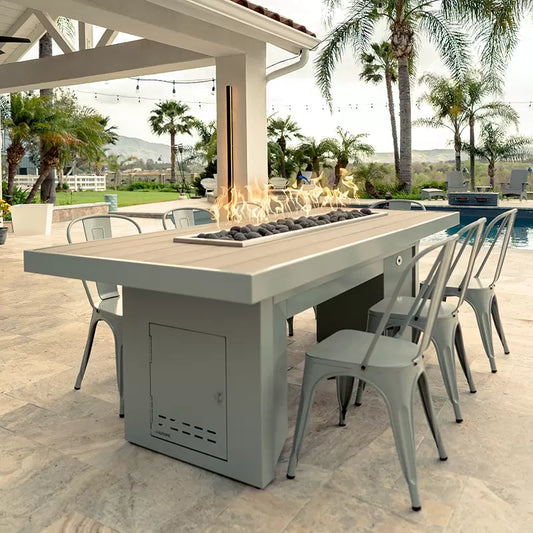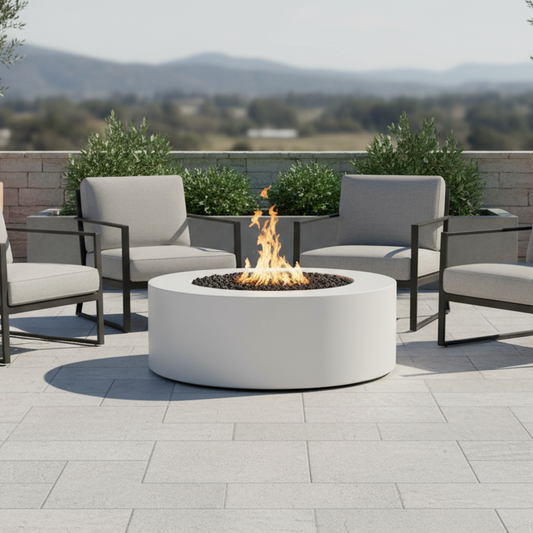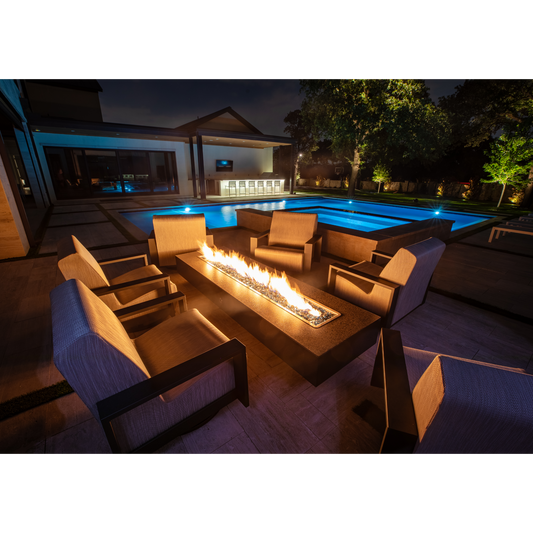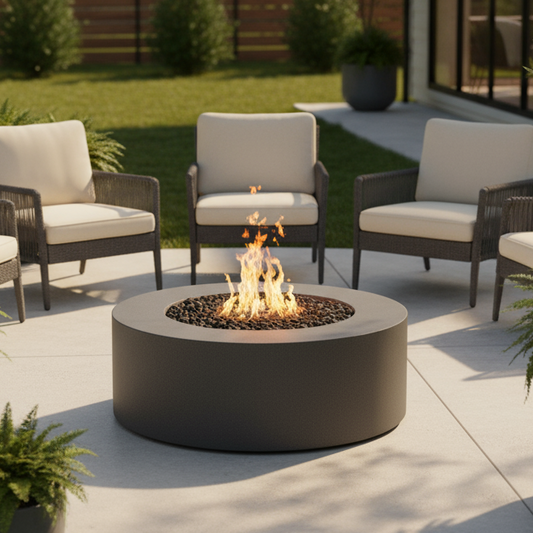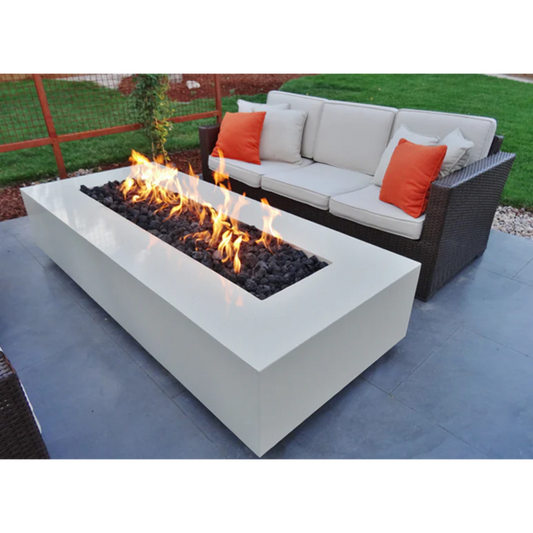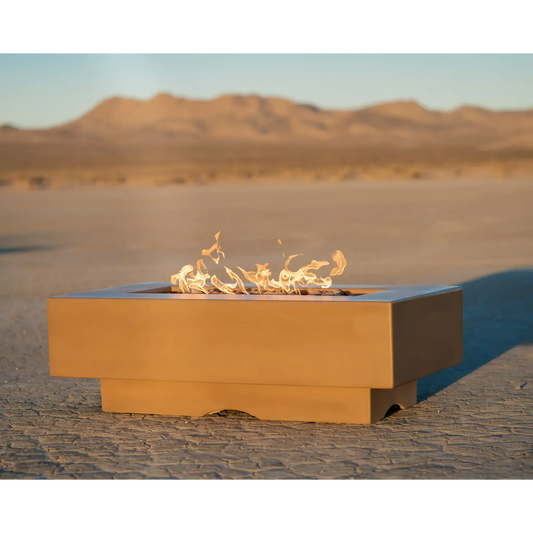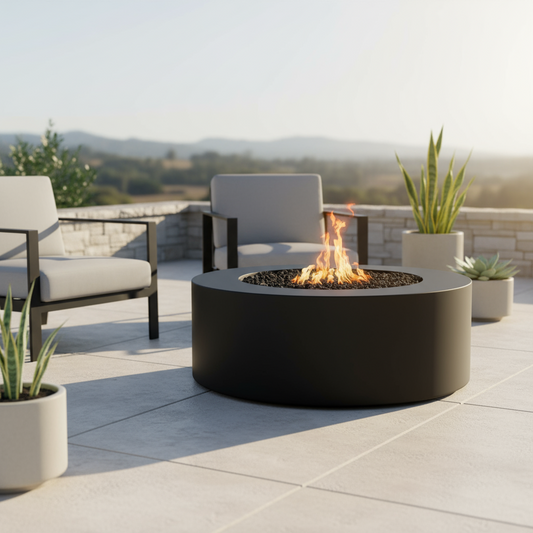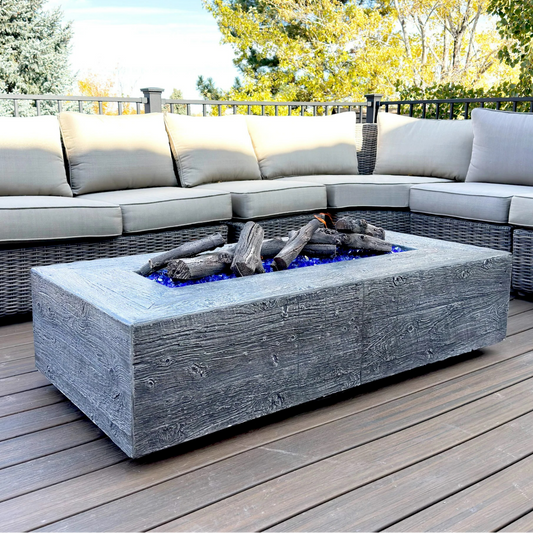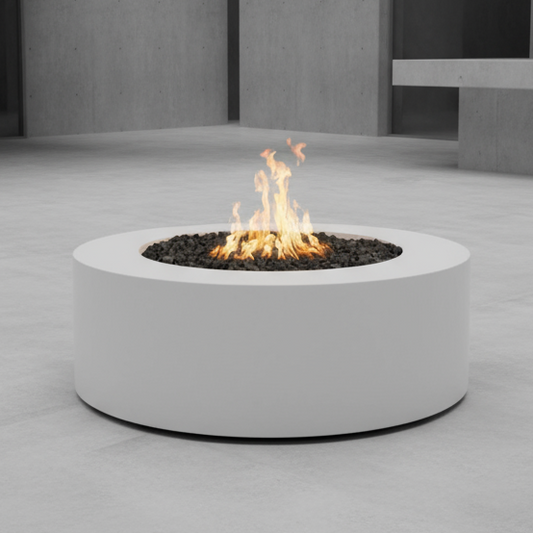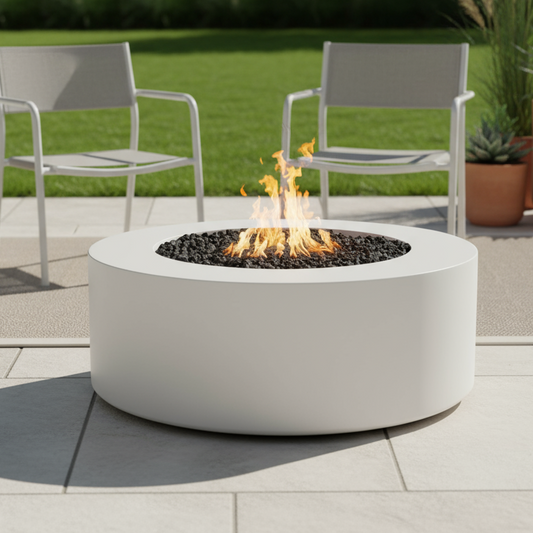Fire Pit & Fire Pit Table Safety: Distances, Decks & Trees (U.S. Homeowner Guide)

Share
Key Takeaways -
- Clearances: Keep a minimum 3 ft (0.9 m) lateral clearance to walls/railings and a minimum 7–8 ft (2.1–2.4 m) overhead clearance to pergolas or canopies—more is better. Wood‑burning units need significantly more. Always follow your owner’s manual and local code.
- Decks: On wood or composite decks, use a fire‑resistant mat/base, confirm weight limits, and maintain vertical clearance. Consider a fire pit stand or feet to improve airflow.
- Pergolas & awnings: Aim for 10 ft (3.0 m) or more above the burner plus open airflow on at least three sides.
- Vegetation & pools: Keep 10 ft (3.0 m) from tree branches and most fencing; avoid placing close to pool edges and textiles.
- Ventilation: Gas/propane features require open air; covered or enclosed spaces trap heat and carbon monoxide.
- Extinguishing: Turn control to OFF, close the LP tank or NG shut‑off, let the unit cool, then cover. Never douse a gas fire with water.
- Troubleshooting: Whistling flames or weak ignition usually means airflow, regulator, or media issues—see the table below.
Quick navigation: Fire Pits & Fire Pit Tables : Complete 2025 Buyer’s Guide.
Table of Content
- Safe Distances
- Deck Safety: Using Fire Pits on Wood, Composite & Stone Decks
- Pergolas, Awnings & Covered Structures
- Trees, Fences & Pools: Natural and Structural Surroundings
- Ventilation & Carbon Monoxide Safety
- How to Extinguish a Gas or Propane Fire Pit Safely
- Troubleshooting: Whistling Flames, Weak Ignition & Flicker Issues
- Quick Reference Tables
- Two Helpful Frameworks You Won’t Find Elsewhere
- Real‑World Problem/Solution Scenarios
- FAQs
- Conclusion
Introduction
The fastest way to enjoy an outdoor flame and still sleep well at night is to respect distances, surfaces, and airflow. Whether you’re using a gas fire pit table, a round fire pit bowl, or a rectangular bowl‑style pit, this guide shows you how far to keep it from houses, railings, pergolas, trees, and pools—and how to use it on wood or composite decks without drama. You’ll also learn how to extinguish a propane unit safely, what to do if your flame whistles or won’t stay lit, and which accessories make a safe fire pit even safer.
If you want broader shopping help, start here: Fire Pits & Fire Pit Tables : Complete 2025 Buyer’s Guide. We broke down sizes, shapes, fuel options, and safety rules so you can shop with confidence. Then circle back here to fine-tune layout clearances and heat zones.
1. Safe Distances

Why clearances matter?
Gas flames give off heat in a cone-shaped pattern. If nearby surfaces—like siding, railings, or cushions—are too close, they can discolor, warp, or even catch fire. Proper spacing allows hot gases to rise and disperse safely, reducing heat buildup and helping the burner work efficiently.
|
Location |
Minimum clearance |
Recommended clearance |
|
House wall, railing, furniture |
3 ft (0.9 m) |
5–7 ft (1.5–2.1 m) |
|
Overhead structures (pergola beams, awnings) |
7–8 ft (2.1–2.4 m) vertical above burner |
10+ ft (3.0 m) with open airflow |
|
Walkways / egress paths |
3 ft (0.9 m) |
4–5 ft (1.2–1.5 m) |
Propane vs natural gas:
- Propane uses a cylinder and regulator. Keep the tank upright and outside, away from heat and direct flame.
- Natural gas runs on a fixed line; confirm shut‑off location is reachable and that run length/pressure matches the burner’s requirements.
If you want to know more about the differences between natural gas and propane fire pit tables, have a look at our dedicated guide — Gas Fire Pit Tables: Natural Gas vs Propane (Costs & Installation). It breaks down everything you need to know about installation, heat output, operating costs, and flexibility, helping you choose the best option for your outdoor space.
Wrap‑up: If you’re torn between two spots, pick the one with more air and fewer overhangs. For precise house setbacks (including distance to soffits and outlets), see: How Far Should a Fire Pit (or Table) Be From the House? or Contact a Specialist.
2. Deck Safety: Using Fire Pits on Wood, Composite & Stone Decks

Can I have a fire pit on my deck? Many homeowners can, especially with gas units, but the deck must handle heat and weight, and the feature must sit on a non‑combustible base. Stone and concrete patios are safest because they conduct heat away; wood and composite need extra protection.
Safe practices for wood/composite decks
- Base layer: Use a fire‑resistant mat (ceramic fiber, stone, or metal) that extends 6–12 in (15–30 cm) beyond the footprint—more for larger bowls.
- Air gap: Add a fire pit stand or feet to raise the base 1–2 in (25–50 mm) for airflow and to prevent heat transfer.
- Vertical clearance: Keep 7–8 ft (2.1–2.4 m) or more to pergola beams or eaves, and open sides for cross‑ventilation.
- Weight check: Confirm the deck’s live load can handle the appliance (GFRC bowls and cast iron can exceed 200–400 lb / 90–180 kg plus media).
- Wind: Use a glass wind guard to prevent flame flicker toward rails and fabrics.
- Carbon monoxide: Never operate in screened‑in or enclosed porches; these trap exhaust.
Mini‑checklist for decks
- □ Base is flat, non‑combustible, and extends past the burner area
- □ Stand/feet used to lift base and improve airflow
- □ Vertical clearance confirmed (no shade sails or plastic panels close overhead)
- □ Shut‑off (LP tank or NG valve) is accessible
- □ Fire extinguisher and heat‑resistant gloves nearby
- □ No storage of spare LP tanks under the table or deck
More detail on this topic can be found here: Can You Have a Fire Pit on a Deck or Under a Pergola?
Fire pit table Accessories – Covers, Wind Guards and Fire Pit Media
3. Pergolas, Awnings & Covered Structures
The concern: Heat accumulates beneath roofs and canopies. Wood beams, vinyl soffits, and fabric can overheat long before they ignite. Gas appliances also need fresh air to burn cleanly.
Practical clearances & airflow
- Vertical space: Aim for 10 ft (3.0 m) or more overhead when possible.
- Open sides: Keep at least three sides open to the outdoors.
- Heat deflectors: If a canopy traps heat, add a non‑combustible heat deflector above the burner—but only if your manual allows it.
- Fabric awnings: Retract while the fire is on.
- Lighting & fans: Keep fixtures well outside the heat envelope. Ceiling fans can push heat down—turn them off while the flame is on.
Problem → Solution
- Problem: The pergola roof gets very hot.
Solution: Raise canopy height or open louvers; relocate the fire pit to an area with taller clearance; add a deflector only if permitted by your model. -
Problem: Soot or odor under the pergola.
Solution: Increase cross‑ventilation; check media depth and burner ports; evaluate wind guard use.
For deeper rules and examples, see: Pergolas, Awnings & Gazebos: Clearance Rules for Fire Pit Tables
4. Trees, Fences & Pools: Natural and Structural Surroundings

Vegetation and structures can dry out, discolor, or catch embers. Even with clean gas flames, radiant heat dries nearby foliage.
Spacing guidance
- Tree branches & hedges: Keep 10 ft (3.0 m) or more from the nearest foliage, including overhead branches. Trim anything that encroaches.
- Fencing & outdoor fabric: Maintain 5–10 ft (1.5–3.0 m) depending on material (more for vinyl or fabric).
- Pool edges & splash zones: Avoid placing flames where chlorinated splash hits the burner or where people exit the pool dripping. Wet decks + LP hose = slip and trip risks.
Dive deeper here: Safe Distances from Trees, Fences & Pools
5. Ventilation & Carbon Monoxide Safety
Open air vs covered spaces. Gas and propane produce carbon monoxide (CO) and need oxygen. Outdoors, wind disperses exhaust quickly. Under covered or partially enclosed structures, exhaust can pool—especially on cold, still nights.
Keep the air moving
- Operate only in open or well‑ventilated spaces with multiple open sides.
- Avoid screened‑in porches and enclosed gazebos.
- If your feature sits inside a masonry surround, provide cross‑ventilation in the enclosure.
- If you smell exhaust or the flame turns lazy/yellow, increase airflow and shut down until resolved.
Problem → Solution
Issue: Low flame and fuel odor.
Fix: Improve cross‑ventilation; verify LP tank is upright; check regulator and supply pressure; ensure media isn’t smothering the burner.
Learn more here: Ventilation & Carbon Monoxide Safety
6. How to Extinguish a Gas or Propane Fire Pit Safely
Do this every time:
-
Turn the control knob to OFF.
-
Close the gas supply. LP: Turn the cylinder valve clockwise (tight). NG: Close the shut‑off valve for the appliance.
- Let the unit cool completely (metal and glass can remain hot for 30–60 minutes).
- Cover only when cold and dry; moisture trapped under a cover can accelerate corrosion.
- Store the cylinder upright, outdoors, and away from heat—never underneath a deck or inside the house.
Don’t do this:
- No water on a gas flame—it can shatter hot glass and damage burners.
- Don’t drape covers over warm fittings.
- Don’t store spare LP cylinders under the table.
Check out one of our Featured dining fire pit tables below - with CSA/UL Certification
7. Troubleshooting: Whistling Flames, Weak Ignition & Flicker Issues
Common issues and quick fixes:
|
Symptom |
Likely cause |
What to try |
|
Whistling flame |
Regulator or gas hose resonance; media covering ports |
Reseat/replace hose; ensure no tight bends; adjust media depth; try a different whistle‑free flex line |
|
Weak ignition / flame won’t stay lit |
Low tank pressure; dirty burner; wind |
Swap/ refill LP; clean ports; use wind guard; check electrode position (spark systems) |
|
Orange, sooty flame |
Poor airflow; media smothering burner; contaminants |
Increase ventilation; lift the burner off the base if allowed; clean media; verify air mixer (LP) |
|
Flame lifts or blows out |
Steady cross‑breeze; improper guard size |
Add or taller wind guard; rotate bowl 90°; relocate to more sheltered position |
|
Flame pops on start |
Residual moisture in media; lighting sequence off |
Dry media thoroughly; follow open → ignite → adjust sequence |
Fire pit table Accessories – Covers, Wind Guards and Fire Pit Media
8. Quick Reference Tables
A. Distance & Clearance Chart (house, deck, pergola, trees)
|
Item |
Minimum |
Recommended |
|
House wall / railing / furniture |
3 ft (0.9 m) |
5–7 ft (1.5–2.1 m) |
|
Overhead clearance (pergola, awning) |
7–8 ft (2.1–2.4 m) |
10+ ft (3.0 m) |
|
From tree branches / hedges |
10 ft (3.0 m) |
12–15 ft (3.6–4.6 m) |
|
From fences (vinyl/wood) |
5 ft (1.5 m) |
8–10 ft (2.4–3.0 m) |
|
Walk path behind seating |
3 ft (0.9 m) |
4–5 ft (1.2–1.5 m) |
These are practical guidelines for gas features. Always follow the owner’s manual and local fire code.
B. Material Safety Table (deck surfaces, pergola types, protective mats)
|
Surface / Structure |
Safe approach |
Notes |
|
Concrete / stone patio |
Place directly; ensure drainage |
Easiest, most forgiving |
|
Paver patio |
Level pavers; consider a tray to catch media |
Watch for rocking pavers |
|
Wood deck |
Fire‑resistant mat + stand/feet + clearances |
Confirm load rating |
|
Composite deck |
Mat + stand + manufacturer approval |
Some brands restrict open flame |
|
Pergola – wood |
10 ft (3.0 m) overhead; open sides |
Retract fabric canopies while in use |
|
Pergola – aluminum/steel |
10 ft (3.0 m) overhead; ventilate |
Metal can get very hot—watch fixtures |
C. Extinguishing & Inspection Frequency
|
Action |
Frequency |
|
Check hose/regulator (LP) for cracks or abrasion |
Monthly |
|
Leak test with soapy water (LP connections) |
Monthly or after any change |
|
Clean burner ports & remove debris |
Monthly |
|
Inspect wind guard hardware and glass |
Monthly |
|
Extinguish by OFF → Shut‑off → Cool → Cover |
Every use |
|
Annual service by qualified tech (gas features) |
Yearly |
9. Two Helpful Frameworks You Won’t Find Elsewhere
Framework 1 — The Three Rings Safety Radius
Visualize three rings around the flame:
- No‑Go Ring: 0–24 in (0–61 cm) — nothing but approved media and burner.
- Safe Ring: 24–48 in (61–122 cm) — no fabrics, décor, or overhanging branches; wind guard lives here.
- Seat Ring: 48–84 in (122–213 cm) — front edges of chairs, with 3–5 ft (0.9–1.5 m) clear path behind for movement.
-> Use the Seat Ring to size your round fire pit bowl or table fire pit: seat edge ≈ 1.5–2.0 × bowl diameter.
Framework 2 — C.L.E.A.R. Setup Check
- C – Clearance: Hit the tables above (3–7 ft lateral; 7–10 ft vertical)
- L – Level: Stable, non‑combustible base with drainage
- E – Exhaust: Cross‑ventilation on at least 3 sides
- A – Access: Shut‑off and extinguisher within reach
- R – Risk controls: Wind guard, mat/stand, and covered LP cylinder location
10. Real‑World Problem/Solution Scenarios
Scenario 1: Propane fire pit table safety on a breezy deck
- Problem: Flame leans toward cushions; guests feel hot on one side and cold on the other.
- Solution: Add a glass wind guard, rotate the burner 90° into the breeze, and increase the seat ring distance by 6–12 in (15–30 cm). If the deck railing traps wind, relocate the pit 1–2 ft (30–60 cm) further inboard. To take a closer look at glass wind guards and other accessories, click here: Fire Pit Accessories
Scenario 2: Fire pit table DIY temptation
- Problem: You saw a video about a DIY conversion using non‑listed parts.
- Risk: Non‑certified burners/regulators can leak, soot, or fail inspection.
- Solution: Use CSA/UL‑listed components and factory ignition kits. If you want a custom surround, keep the ventilation openings and clearances specified by the manufacturer. (DIY furniture around a listed burner is fine when built to spec.)
Learn more here: Ventilation & Carbon Monoxide Safety
-
Start browsing certified options here: Certified Fire Pit Tables
- Add safety accessories: Fire Pit Accessories
-
Need tailored advice for your deck or pergola? Contact a Specialist
11. FAQs
Is a propane fire pit table safe on a deck?
Yes—when you use a fire‑resistant mat, maintain clearances, and ensure open airflow. Keep the LP cylinder upright and outside, and never store spares under the table.
What are your top fire pit tips for first‑time owners?
Start with clearances, add a wind guard if breezy, keep a fire extinguisher nearby, and perform a quick leak test (LP) after moving or reconnecting hoses.
Do I need a fire pit stand?
On wood/composite decks a stand or feet helps airflow and reduces heat transfer. It also keeps the base drier after rain.
Can I build a fire pit table DIY?
You can build the surround (stone/steel table) if you maintain vent openings and clearances, but use a listed burner/ignition kit. Avoid mixing non‑listed parts.
What’s a safe fire pit distance from the house?
As a rule, 3 ft (0.9 m) minimum lateral and 7–10 ft (2.1–3.0 m) overhead for gas features—more space is safer. Check your manual and local code.
Does a table fire pit need a wind guard?
Not always, but it improves comfort and stability on decks and rooftops. It also protects glassware and fabrics near the flame.
12. Conclusion
Safe, satisfying outdoor flames come down to clearances, surfaces, ventilation, and smart shutdowns. Give your fire pit bowl or gas fire pit table space to breathe, protect decks with mats and stands, keep vegetation and fabrics out of the heat cone, and shut down correctly every time. When in doubt, choose the spot with more sky above and more air around—and consult your manual and local code.
Next steps:
- Compare fire pit options: Fire Pit Tables
- For shopping guidance, start here: Fire Pits & Fire Pit Tables : Complete 2025 Buyer’s Guide
- Need a plan for your deck or pergola? Contact a Specialist


